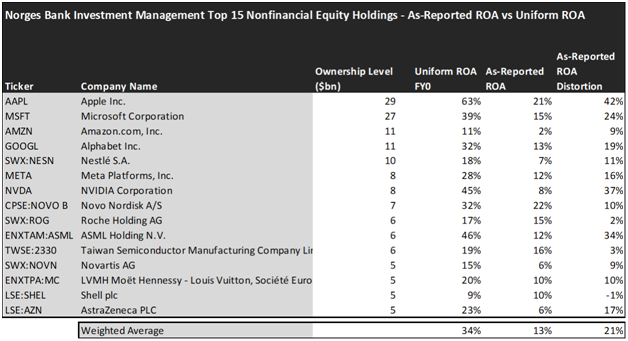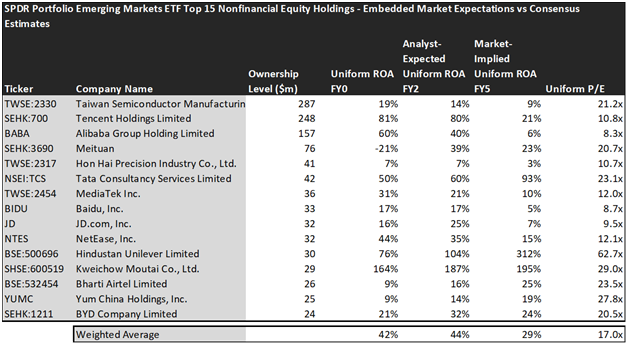With the volatile market condition, rising interest rates, and recession concerns, investors should exercise prudence and lean towards safe investments. Conservative funds such as pension funds and sovereign wealth funds can be a good place for investors who wants to be extra cautious. In today’s FA Alpha Daily, we’ll take a closer look at the world’s largest sovereign wealth fund, Norges Bank Investment Management, and determine the companies it has invested into.
FA Alpha Daily:
Friday Portfolio Analysis
Powered by Valens Research
A looming recession is the latest talk on the street. Inflation has persisted longer than people expected, banks are collapsing, and the U.S. is on the verge of reaching its debt ceiling.
More importantly, lending standards are getting tighter, signaling that we may actually have credit markets start slowing down soon.
That means investors need to invest cautiously, and they need to pick safe investments, or they will be crushed when the market falls.
Almost nobody needs to play the investment game more conservatively than pension funds and similar vehicles. They are investing in people’s retirement, and they can only take a little risk.
Sovereign wealth funds operate similarly. They fund social programs that need to keep the lights on forever.
One entity that exemplifies such a cautious and prudent approach to investing is the Norges Bank Investment Management, which is Norway’s Sovereign Wealth Fund.
The fund was established in 1990 to manage the country’s oil and gas revenues. It aims to safeguard the wealth generated from these finite resources for future generations.
With a market value exceeding $1.3 trillion, the Norges Bank Investment Management has become the world’s largest of its kind.
Its massive size and conservative investment approach allow it to weather market turbulence more effectively than most other funds.
Rather than pursuing high-risk ventures, the fund focuses on diversification across asset classes, sectors, and geographies to mitigate risk and ensure a steady return on investment.
Let’s have a look at the fund’s top holdings and see what equities it’s holding to play the recession.
Economic productivity is massively misunderstood on Wall Street. This is reflected by the 130+ distortions in the Generally Accepted Accounting Principles (GAAP) that make as-reported results poor representations of real economic productivity.
These distortions include the poor capitalization of R&D, the use of goodwill and intangibles to inflate a company’s asset base, a poor understanding of one-off expense line items, as well as flawed acquisition accounting.
It’s no surprise that once many of these distortions are accounted for, it becomes apparent which companies are in real robust profitability and which may not be as strong of an investment.
See for yourself below.

It’s no surprise to see several of the world’s biggest companies on the list.
That said, looking at as-reported accounting numbers, investors would think Norges Bank Investment Management is not successful in its strategy at all.
On an as-reported basis, many of the companies in the fund are just average performers. The average as-reported ROA for the top 15 holdings of the fund is 13%, which is slightly above the U.S. corporate average.
However, once we make Uniform Accounting adjustments to accurately calculate the earning power, we can see that the average return in Norges Bank Investment Management’s top 15 holdings is actually 34%.
As the distortions from as-reported accounting are removed, we can see that Nvidia Corporation (NVDA) isn’t an 8% return business. Its Uniform ROA is 45%.
Meanwhile, AstraZeneca (LSE:AZN) looks like a poor performer with only a 6% return, but this massive pharmaceutical company actually powers a 23% Uniform ROA.
That being said, to find companies that can deliver alpha beyond the market, just finding companies where as-reported metrics misrepresent a company’s real profitability is insufficient.
To really generate alpha, any investor also needs to identify where the market is significantly undervaluing the company’s potential.
These dislocations demonstrate that most of these firms are in a different financial position than GAAP may make their books appear. But there is another crucial step in the search for alpha. Investors need also to find companies that are performing better than their valuations imply.
Valens has built a systematic process called Embedded Expectations Analysis to help investors get a sense of the future performance already baked into a company’s current stock price. Take a look:

This chart shows four interesting data points:
- The average Uniform ROA among Norges Bank Investment Management’s top 15 holdings is actually 34%, which is much better than the corporate average in the United States.
- The analyst-expected Uniform ROA represents what ROA is forecasted to do over the next two years. To get the ROA value, we take consensus Wall Street estimates and convert them to the Uniform Accounting framework.
- The market-implied Uniform ROA is what the market thinks Uniform ROA is going to be in the three years following the analyst expectations, which for most companies here are 2023, 2024, and 2025. Here, we show the sort of economic productivity a company needs to achieve to justify its current stock price.
- The Uniform P/E is our measure of how expensive a company is relative to its Uniform earnings. For reference, the average Uniform P/E across the investing universe is roughly 20x.
Embedded Expectations Analysis of Norges Bank Investment Management paints a clear picture. Overall, Norges doesn’t care about finding value investments today. It cares about quality.
The average Uniform P/E ratio of the top 15 holdings is 26 times. That’s above the market average. And on average, the companies are expected to keep performing.
As we mentioned, the top holdings’ average Uniform ROA is 34%. Analysts forecast the portfolio holdings on average to see Uniform ROA decline slightly to 29% over the next two years. At current valuations, the market’s expectations are slightly higher than analysts and it expects a 32% Uniform ROA for the companies in the portfolio.
For instance, Apple (AAPL) returned 63% this year. Analysts think its returns will fall to 50%. And at a 25.8x Uniform P/E, the market expects profitability to decline as well and is pricing Uniform ROA to be around 54%.
Similarly, Microsoft’s (MSFT) Uniform ROA is 39%. Analysts expect its returns will drop to 35%, but the market is slightly more optimistic and pricing its returns to remain around 39%.
Overall, we can see that Norges Bank Investment Management’s top holdings are composed of well-known and high-quality companies all around the world. And while the market recognizes these companies for what they are, that’s not a bad thing in an uncertain environment.
Norges is willing to pay a premium for stable returns.
Investors should be cautious while investing this year and should carefully analyze the current valuations and the market’s expectations in this highly volatile market.
This just goes to show the importance of valuation in the investing process. Finding a company with strong profitability and growth is only half of the process. The other, just as important part, is attaching reasonable valuations to the companies and understanding which have upside that has not been fully priced into their current prices.
To see a list of companies that have great performance and stability also at attractive valuations, the Valens Conviction Long Idea List is the place to look. The conviction list is powered by the Valens database, which offers access to full Uniform Accounting metrics for thousands of companies.
Click here to get access.
Read on to see a detailed tearsheet of one of Norges Bank Investment Management’s largest holdings.
SUMMARY and Nestlé S.A. Tearsheet
As one of Norges Bank Investment Management’s largest individual stock holdings, we’re highlighting Nestlé S.A. (NESN:CHE) tearsheet today.
As the Uniform Accounting tearsheet for Nestlé S.A. highlights, its Uniform P/E trades at 29.5x, which is above the global corporate average of 18.4x, but at its historical average of 29.5x.
High P/Es require high EPS growth to sustain them. In the case of Nestlé S.A., the company has recently shown 1% Uniform EPS shrinkage.
Wall Street analysts provide stock and valuation recommendations that, in general, provide very poor guidance or insight. However, Wall Street analysts’ near-term earnings forecasts tend to have relevant information.
We take Wall Street forecasts for GAAP earnings and convert them to Uniform earnings forecasts. When we do this, Nestlé S.A.’s Wall Street analyst-driven forecast is for EPS to grow by 6% and 7% in 2023 and 2024, respectively.
Furthermore, the company’s return on assets was 18% in 2022, which is 3x long-run corporate averages. Also, cash flows and cash on hand consistently exceed its total obligations—including debt maturities and CAPEX maintenance. Moreover, its intrinsic credit risk is 40bps above the risk-free rate. Together, these signal low dividend risks and low credit risks.
Lastly, Nestlé S.A.’s Uniform earnings growth is below peer averages, and it is above peer valuations.
Best regards,
Joel Litman & Rob Spivey
Chief Investment Strategist &
Director of Research
at Valens Research
This portfolio analysis highlights the same insights we share with our FA Alpha Members. To find out more, visit our website.
